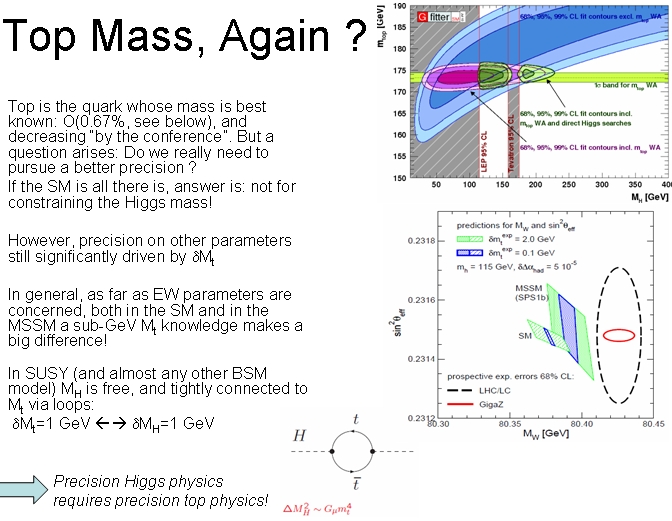I have been assigned a talk titled "Top Physics at the Tevatron", and I will therefore represent the CDF and DZERO collaborations and describe their results. It will be very interesting for me to inform my CMS colleagues about the newest experimental techniques in use at the Tevatron to measure the properties of the top quark in hadronic collisions.
As soon as I find some time, I will publish here a few of the slides of my talk, trying to explain them in simple terms. For the time being, let me just paste here the draft of one slide I consider important and of general interest: an explanation of why the top quark mass, now known with 0.67% accuracy thanks to the huge effort of the two experiments, may still provide additional crucial information on the fundamental theory of subatomic particles if its uncertainty is further reduced in the next few years.

In a nutshell, the slide makes a few points about the importance of a precise measurement of the top mass. The simple-minded argument that the top mass is a decisive input in electroweak fits to Standard Model (SM) observables when the aim is a prediction of the unknown mass of the Higgs boson fails nowadays, since the top quark is already known with enough accuracy for that purpose, as compared to other SM parameters. You can observe it in the top right graph, where the horizontal axis describes the unknown Higgs boson mass, and the vertical axis the top quark mass. The blue oblong region is the area where the two parameters are bound to lay if we believe the measurement of all other electroweak observables. The green region instead includes in the fit the known value of the top mass, which is also shown as a light green horizontal band.
As you can see, the inclusion of the top mass strongly constrains the allowed values of the top mass, precisely to lay within the two oval green regions. Note that the LEP II lower bound on the Higgs mass and the Tevatron excluded window between 156 and 173 GeV (shown in grey) significantly help reduce the extent of those regions (which would otherwise include the pink areas). Now, ask yourself the question: if we shrunk the top mass band to a narrow horizontal line, how much would the green areas shrink consequently ? The answer is, minimally! So a more precise top quark mass is not needed if all we want is to improve our indirect knowledge of the Higgs boson's mass.
It turns out, however, that other EW parameters in the SM are still benefitting a lot from an increased precision in the mass of the top quark. This is shown in the figure on the lower right (which comes from a highly interesting, if not very recent, paper by S.Heinemeyer et al., hep-ph/0306181) which however is a bit too complicated for me to explain meaningfully in a few lines. Suffices to say that both for the Standard Model, and for most of the Beyond-the-Standard-Model scenarios, a better-known top mass remains highly desirable to this day!





Comments